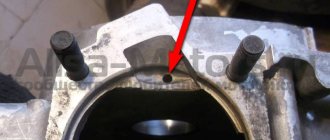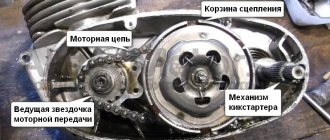Motor oil is one of the essential elements of a car engine. It is used to lubricate pistons or rotors in an internal combustion engine, preventing overheating. Due to the added active additives, the resistance of the lubricated surfaces to the occurrence of corrosion processes increases, and the oil itself will not thicken or freeze. One of the main criteria when choosing engine oil is its type:
- Mineral - not very widespread, mainly used in engines that were produced quite a long time ago. It has a low viscosity index, which can make starting the engine in severe frost difficult;
- Semi-synthetic - has a higher viscosity index compared to mineral products. It costs significantly more. This type of oil has absorbed the main advantages of mineral and synthetic compounds; with its help, the coefficient of friction in the engine is reduced by about 5%! This oil can be used at high and extremely low temperatures and maintain its performance for a long time;
- Synthetic - may have different performance qualities depending on what additives were added to the composition during production. It practically does not evaporate, provides low friction, and performs well at high and low temperatures. The only drawback compared to semi-synthetic products is the very high price.
When compiling the rating of the best motor oils, we took into account many factors: performance capabilities, price, consumer reviews. Here are the compositions that are ideal in terms of price and quality.
Recommendations for choosing motor oil for a motorcycle
Types of motor oils
. Motor vehicles are equipped with two types of internal combustion engines.
- Two-stroke engines are installed on scooters and light motorcycles. Oil is added to gasoline, after which the mixture is poured into the fuel tank. Therefore, a number of requirements are imposed on the lubricant, starting with the usual characteristics (coefficient of friction, detergency, oxidation resistance) and ending with the speed of mixing with gasoline. The proportions for preparing the fuel mixture are given in the motorcycle manual. Usually one part of oil is added to 40-50 parts of gasoline.
- Most modern motorcycles are equipped with four-stroke engines. Motor oil is poured into the engine, just like in cars. One of the main requirements for lubricant is the preservation of all properties during its service life, i.e. until scheduled replacement.
Oil base
. Motorcycles can be filled with oil made using one of three technologies.
- The simplest and most affordable is mineral-based lubricant. Synthetic additives are introduced into refined petroleum products; their symbiosis produces a high-quality product. It can also be poured into motorcycle transmissions. Mineral water is suitable for seasonal (in warm weather) use of motorcycles.
- In semi-synthetics, the share of synthetic compounds reaches 50%! This lubricating fluid maintains stable viscosity even in slight frost. It is recommended to use semi-synthetics in engines with a small cylinder capacity. Experts also advise switching to this type of oil when the engine reaches old age and the problem of waste becomes acute.
- Synthetic oil is made not only from petroleum, but also from natural gas. Moreover, the “gas” version is considered a true 100% synthetic. Manufacturers produce both universal products that can be used in any motorcycle, as well as highly specialized ones (for example, for racing bikes). The main disadvantage of such a lubricant remains its high price.
- Features of standards for motorcycle oil. Since 1998, the JASO T 903 standard has been in force, which sets out the requirements for motor oil for motorcycles. This primarily concerns lubricants for 4-stroke engines. A distinctive feature from automotive products is that they are tested in a “wet” clutch. In 2006, the standard was updated; if a material has not been certified by the Japanese organization JASO, it cannot be recommended for use in motorcycles.
We have selected the 12 best motorcycle oils for review. They are widely represented in the Russian trading network. When allocating seats, the opinion of the expert community and reviews of domestic motorcyclists were taken into account.
What do the abbreviations and markings on the packaging of motor oils for motorcycles mean?
For novice motorcyclists, it is the unclear designations on the label that raise many questions. Manufacturers use standard designations, but they are not always obvious to users. As a result, vehicle owners cannot choose the desired lubrication option. It's actually simple.
Oil for motorcycles is labeled in the same way as for cars. With this in mind, it is worth paying attention to the technical characteristics of the lubricant indicated on the bottle label. Typically, buyers take into account:
- product viscosity;
- seasonality of use;
- tolerances and compliance;
- ash content indicator.
The type of lubricant must be taken into account. For old motorcycles, it is best to buy mineral water, but for new ones - exclusively synthetics. Each manufacturer gives recommendations for the oil. This data can serve as a kind of hint for the owner of the equipment. In the future, the oil will need to be changed every 6 thousand km. Experienced motorcycle owners replace them once a year, in the autumn.
Rating of the best motor oils
10+. ZIC XQ LS 5W-30 4 l
This is a completely synthetic composition of very high quality. The production process used the most modern Low Saps technology, which ensures low sulfur, ash and phosphorus content. It can be used in gasoline and diesel engines equipped with a turbocharging system.
The oil is all-season and works well even in the most extreme temperature conditions. It extends the life of the motor and various types of filters aimed at reducing the emission of harmful substances into the environment. In the engine itself during operation there will be almost no soot and various types of deposits. The oil is acceptable for use in engines that comply with the Euro-IV standard, where a lot of attention is paid to the amount of emissions into the atmosphere.
Advantages:
- Low price;
- Retains its performance qualities for a long time;
- Holds high and low temperatures well.
Flaws:
- Only the highest quality gasoline should be poured into the engine with this oil;
- You can’t find it in every store; you often come across fake compounds.
GENERAL MOTORS Dexos2 Longlife 5W30 4 l
This is a synthetic oil that can be used at ambient temperatures down to -25 degrees, since when the engine starts, the oil pump must quickly deliver the composition to all rubbing elements of the mechanism. If this does not happen, friction and wear rates increase. In the summer, the oil retains its qualities at temperatures up to +50 degrees, due to which the engine does not jam during long periods of inactivity, for example, in a traffic jam, or if the cooling system is not operating correctly.
More: TOP 10 best walkie-talkies for hunting, tourism and truckers
This composition is intended for use in cars of most domestic and foreign brands, even if the gasoline was filled with low-quality gasoline. The cost of the oil is quite high, but its consumption is much less compared to other formulations, and you won’t have to add it too often. With the help of such oil, it is possible to achieve certain fuel savings; it extends the service life of various filters - oil and air. During operation, there are no air bubbles or foam in the oil. The manufacturer allows the use of the composition as a hydraulic fluid.
Mineral motorcycle oil
Mineral oils are more suitable for older motorcycles because they are heavier and do not leak. Owners who change mineral water to synthetic oils can cause an oil leak.
But you should know that older motorcycles may not always have the correct oil, due to the fact that the oil was tailored for those motorcycles that were produced at the time this oil was developed. However, today's generation of oils will be much better than it was before.
When it comes to modern motorcycles, most mechanics believe that synthetic oil is better, especially after the first service.
There are many benefits of synthetic oils, including the fact that they are better at properly lubricating surfaces and operating at high performance, high engine speeds, especially when operating in hot climates.
Rating of the best oils for motorcycles
| Nomination | place | Name of product | price per liter |
| Rating of the best oils for motorcycles | 1 | Motul 300V Factory Line Road Racing 10W40 | 1 201 ₽ |
| 2 | REPSOL MOTO RACING 4T 10W40 | 957 ₽ | |
| 3 | LIQUI MOLY Motorbike 4T 15W-50 Street | 530 ₽ | |
| 4 | MOTUL 7100 4T 10W-50 | 1 003 ₽ | |
| 5 | Eni/Agip i-Ride Scooter 2T | 424 ₽ | |
| 6 | IDEMITSU 4T Max Eco 10W-30 | 329 ₽ | |
| 7 | ZIC M9 4T 10W-40 | 447 ₽ | |
| 8 | ELF HTX 3818 SAE 5W-30 | 539 ₽ | |
| 9 | MOBIL 1 Racing 4T 15W-50 | 988 ₽ | |
| 10 | CASTROL Power 1 Racing 4T 10W-40 | 860 ₽ | |
| 11 | KAWASAKI Performance Oils 4-Stroke Engine Oil Semi Synthetic SAE 10W-40 | 928 ₽ | |
| 12 | Eurol Motorcycle 10W-40 | 450 ₽ |
Motul 300V Factory Line Road Racing 10W40
Rating: 4.9
Maximum protection for engine parts during critical loads is provided by the French Motul 300V Factory Line Road Racing 10W40 oil. The product is created on the basis of the purest synthetics, which is obtained using Ester Core technology. The manufacturer has developed a set of unique additives that provide high efficiency to the oil. Experts recommend using lubricant in modern motorcycles with exhaust gas aftertreatment systems. Since the oil cannot be mixed with other lubricants, the engine should be thoroughly rinsed with a special compound before use. The product wins our rating.
Russian motorcyclists note the stability of pressure in the oil line, regardless of operating modes. The only drawback of the lubricant is the high price.
Advantages
- synthetic base;
- innovative additives;
- versatility;
- durability.
Flaws
- high price.
REPSOL MOTO RACING 4T 10W40
Rating: 4.8
REPSOL MOTO RACING 4T 10W40 engine oil was developed specifically for four-stroke motorcycle engines. The Spanish manufacturer took 100% synthetics as a basis. Thanks to the latest generation additives, it was possible to achieve excellent cleaning properties and protect rubbing parts from wear. The oil remains stable under different operating conditions; it is suitable for both European and Japanese bikes. Stable viscosity is maintained even at low temperatures, which allows trouble-free engine starting. Experts gave the product silver in our rating for its excellent combination of price and quality.
Domestic users are satisfied with the technical characteristics of the Spanish lubricant and affordable price. But the product is rarely found in the country's retail chain.
Advantages
- synthetic base;
- high cleaning abilities;
- affordable price;
- wear resistance.
Flaws
- shortage in Russian stores.
LIQUI MOLY Motorbike 4T 15W-50 Street 4 l
Rating: 4.7
LIQUI MOLY Motorbike 4T 15W-50 Street 4 l motor oil is widely used. It can be poured into bikes with 4-stroke engines equipped with different transmissions and cooling systems. These can be motorcycles, ATVs or outboard boat motors. The product is also suitable for motorcycle gearboxes. Experts highly appreciated the cleanliness of power units that worked with German lubricant. The advantages of the material also include long service life and the absence of waste. One of the reasons for the effectiveness of the oil is the introduction of titanium and sodium compounds into the composition. The product becomes a bronze medalist in our rating.
In reviews, domestic bikers praise German oil for its high quality, economical consumption, and durability. The disadvantage is the high price.
Advantages
- wide scope of application;
- excellent cleaning ability;
- economical consumption;
- durability.
Flaws
- high price.
MOTUL 7100 4T 10W-50
Rating: 4.6
MOTUL 7100 4T 10W-50 lubricant has been created for modern motorcycle engines. It is recommended to be poured into engines that comply with EURO 2 and EURO 3 standards. The product is developed using ester technology, thanks to which it was possible to reduce the coefficient of friction. An anti-wear additive complex ensures long lubricant service life. Experts note the optimal ratio of sulfur and phosphorus compounds in the composition. This is especially important for engines equipped with gas neutralization systems. The product stopped one step away from the top three rating due to its high price and shortage in the Russian retail chain.
Users note the high quality of the oil and the absence of waste. But buying this lubricant is quite difficult.
Advantages
- modern cooking technology;
- wide scope of application;
- low friction;
- wear resistance.
Flaws
- high price;
- shortage in the trading network.
Eni/Agip i-Ride Scooter 2T
Rating: 4.5
Italian oil Eni/Agip i-Ride Scooter 2T is very popular among motorcycle owners in the Apennines. The lubricant is intended for two-stroke engines, so it is added to gasoline. Experts appreciated the rapid mixing of oil with fuel, and this was observed at both high and low temperatures. The advantages of the product include low sulfur content and lack of soot. For effectively reducing friction when the engine operates at maximum loads, the lubricant is included in our rating.
Owners of scooters and mopeds speak flatteringly about the affordable price, decent quality and the absence of counterfeits on the Russian market. Users consider the downside to be the disgusting container, in which the filler neck is often damaged.
Advantages
- affordable price;
- good quality;
- stable viscosity;
- effective friction reduction.
Flaws
- The neck of the container breaks.
IDEMITSU 4T Max Eco 10W-30
Rating: 4.4
Despite its mineral base, IDEMITSU 4T Max Eco 10W-30 engine oil managed to get into the TOP 6 of our rating. The product is designed for 4-stroke engines with aftertreatment and wet clutch. Experts drew attention to the cost-effectiveness of lubrication, which is especially noticeable when traveling long distances. Thanks to its good lubricating properties, the operation of the power unit becomes quieter and vibration is reduced. The liquid effectively combats carbon deposits at high temperatures. The clutch also works smoothly, there are no jerks when shifting gears.
Advantages of branded Super and Ultra class motor oils
- compliance with current environmental requirements;
- complete and effective protection of engine rubbing parts from accelerated wear;
- absence of sediment and stability of operating parameters during long-term storage.
Branded lubricants do not require any additives or additional components. It should be borne in mind that fuel mixtures prepared using mineral oils and their synthetic analogues are prohibited from mixing.
Which motorcycle oil to choose in 2021
If motorcycles are officially , contact the dealer and ask what oil is recommended. This method is not suitable for equipment supplied by other means. Use the manual, which contains the necessary information.
Characteristics are prescribed using various standards:
The Japanese standard takes into account the friction coefficient, on which the clutch operation depends. MV is a lubricant with a low coefficient, MA1 is a medium coefficient, MA2 is a high coefficient. Select according to clutch type.
For two-stroke motorcycles, the Japanese produce oils FA, FB, FC, FD. Quality increases in order of priority, the best product is FD.
If the motorcycle is used in a gentle mode , does not participate in racing, does not travel off-road, it is allowed to fill in cheap engine oil . The equipment lasts a long time, if you do not forget about regular replacement of lubricant, the condition of the filter elements and the pump.
Owners of two-stroke motorcycles must maintain the proportion of oil and gasoline and replace the fluid if necessary.
Source
Which lubricant is suitable for 2-stroke and 4-stroke engines?
Attention should be paid to the choice of lubricant for the fork
The lubrication system of 2-stroke and 4-stroke engines differs significantly from each other. The system of 2-stroke engines is quite simple; here the lubricant is supplied directly to the combustion chamber along with the fuel used, where it treats all rubbing surfaces. If the engine oil does not burn completely, it is discharged through a certain engine exhaust system with exhaust gases.
Due to this type of engine operation, lubricants used for two-stroke engines contain certain additives that differ significantly from those used in 4-stroke engines. The choice of oils for motorcycles with 2-stroke engines is not very large, so you can fill in any oil that is thinner than for 4-stroke engines. For 4-stroke engines, the choice is much wider, which is why it is necessary to select them, taking into account certain parameters.
It is best to use motor oil for its intended purpose, depending on the type of engine. For a modern motorcycle, the lubricant must certainly contain certain additives and have optimal viscosity. In addition, it must be designed to operate at high temperatures and engine speeds.
In addition, it is very important to accurately select the oil for the motorcycle fork. Changing the oil in a motorcycle fork is carried out for preventive purposes; it will help maintain the required level of suspension performance. To properly pour oil into the fork, you must use the exact amount of oil. In addition, it is necessary to fill the fork with oil with a certain viscosity level, because otherwise the motorcycle may malfunction.
An equally important issue is the proper maintenance of motorcycle shock absorbers. Shock absorbers are often exposed to elevated temperatures. Elevated temperatures and various contaminants contribute to the deterioration of the quality of the lubricant used and reduce the performance of the shock absorber.
To prevent significant wear of all internal parts, it is necessary to carry out mandatory maintenance of the shock absorber almost every day and it is advisable to use engine oil for this. It is necessary to change the lubricant for the shock absorber very often, because many harmful substances accumulate in its body. Properly selected motor lubricant improves the quality of shock absorbers.
Which oil has the right to be called motorcycle oil?
1. Design features of motorcycle engines
2. Motorcycle engine operating modes
3. Classifications of motorcycle oils.
4. Base oils for the production of motor oils for motorcycles
5. Preferred base oils
6. Independent tests
7. Building an assortment
8. Which oil should I choose for my motorcycle?
Motorcycle power plants are designed on the principle of maximum power and compactness, with minimal weight. That is why designers combine the engine itself and the gearbox with clutch into a single unit, which is also located in a single oil bath due to the convenience of cooling the unit.
Units that, by automotive standards, are considered attachments are often placed there: a generator, a water pump, an ignition distributor, etc. The oil is forced to work simultaneously, both as a motor oil and as a transmission oil, and to provide the necessary coefficient of friction for the clutch mechanism, because the clutch operates in the same oil bath.
Plus, the oil washes the clutch clutches and the generator in an oil bath. That is, it should not be aggressive to varnish, friction and adhesive materials. The situation is aggravated by the fact that motorcycle engines are highly boosted, both in speed and in temperature, which imposes certain restrictions on engine oil in terms of pumping and foaming.
The mode of operation of a motorcycle in the city is to shoot from traffic light to traffic light and briefly park at red. The mode is extremely unfavorable for the engine, since the engine is used at maximum power while it is running, and during a short stop it releases the accumulated heat, that is, it experiences thermal shock. To protect against sticking in such a situation, the clearances in the cylinder-piston group of a motorcycle engine are larger than in a car engine. Therefore, motorcycle oil cannot have a reduced high-temperature HTHS viscosity, a reduced oil film thickness, that is, it cannot be energy-saving in the automotive sense. Motor oil must also have a high flash point and low volatility, that is, translated into automotive language, it is considered “racing”.
If we compare motorcycle and automobile oils by alkalinity number, then motorcycle oil can be classified as a low-ash oil with a reduced alkalinity of 6-8 mgKOH\g, versus 8-12 mg\KOH for universal automobile oils.
To summarize: motorcycle engine oil is radically different from universal automobile oil in the following parameters: coefficient of friction, base number, foaming, volatility, aggressiveness to polymeric materials, flash point and high-temperature viscosity. That is, motor oil is a completely special product.
The only international classification, the Japanese JASO (Japanese Automotive Standards Organization) has a section that clearly defines the belonging of 4-stroke oil to motorcycle classes.
The JASO M (moto) classification divides motor oils into oils with normal and reduced friction coefficients: MV - oils with a reduced friction coefficient, incompatible with the clutch mechanism in an oil bath, MA oils - oils with a normal friction coefficient, adapted for wet clutches. MA2 – class for wet clutch, with improved cleaning properties, adapted for high-power engines. In addition to the JASO class, a motor oil may comply with the American API classification, for example: JASO MA approximately corresponds to API SG, and JASO MA2 also approximately corresponds to API SL-SM.
Basic bases on which motorcycle oils are made: Motor oils, just like automobile oils, are made on API groups 2, 3 and 4 bases, that is, manufacturers use purely mineral, hydrocracking and polyalphaolefin (PAO) bases. The essential (ester) base of group 5 in its pure form is not used due to its serious disadvantages: price, hygroscopicity (absorbs moisture) and unpredictability of behavior during long-term use. Despite the powerful advertising of 100% ester oil, esters are added to cracking oils, almost in homeopathic doses, as an additive to increase adhesion and reduce the aggressiveness of the base to seal materials. But some manufacturers make extra profits by calling their cracking oils ester oils. Ester oils have not been made from vegetable raw materials for about twenty years.
What basic principles are preferable for certain cases?
Mineral oils are considered to be a thing of the past and completely undeservedly. Mineral oils are preferably used in air-cooled engines. Mineral oils contain relatively few polymer thickeners, which increases the oil's resistance to loss of viscosity due to thermal stress. But it is preferable to use mineral water in classic and rare equipment, while the most modern motorcycles are still poured with synthetics.
Hydrocracking oils are used today by most motorcyclists, out of habit calling them semi-synthetics. Such is the power of tradition. But some, mostly American manufacturers, go further and write the proud name “full synthetics” on the cracked cans. In their own way, they are right, firstly, American laws allow this, and secondly, cracked oils are not much inferior to full synthetics in properties. German manufacturers are much more honest, religiously following their native German DIN, the German industrial standard, in which it is written in German that only oils of API groups 4 and 5 can be called full synthetics. That is, full synthetics, these are PAO oils and esters.
Let's look at the range of 4-stroke motorcycle oils using the example of products from Liqui Moly GmbH. All motor oils are divided into two categories according to conditions of use: Street and Offroad.
Street - the engines of road motorcycles operate at high speeds and often, when stopping suddenly at a traffic light, thermal stroke is possible due to a sharp deterioration in cooling by the incoming air. These features were taken into account when developing the additive package; the package was strengthened with additional antioxidant and anti-foam components. In addition, in road motorcycle engines, the oil is changed according to a certain mileage, and not according to engine hours.
Offroad - Off-road motorcycles operate at lower speeds, but at higher shock loads and temperatures. Speeds are lower, weaker and cooling, these circumstances contribute to constant overheating. Sometimes, excess heat from the engine can cause gasoline to boil in the gas tank. In addition, off-road there is more dust and water. Both can get into the engine. Therefore, oils for off-road motorcycles have a reinforced base, are able to separate water well and resist loss of viscosity due to elevated temperatures and the ingress of some fuel into the oil itself. The protective properties of Offroad oils against shock loads and corrosion have been additionally enhanced. Oil changes in off-road motorcycles are carried out according to engine hours.
The Street and Offroad categories are divided into groups:
RACE are fully synthetic PAO based oils for those who get the most out of their motorcycle and need extreme protection even beyond the engine's lifespan. Motor oil retains its properties under sports operating conditions and is suitable for sports modifications of equipment and for motorcycles with additionally installed engine tuning elements. 100% synthetic Race oils are the most durable motor oils with a reserve of properties in all areas.
HC-synthetics (hydrocracking, Synthese Technologie) - oils for use under normal conditions, without extreme conditions. Oils on this basis provide excellent protection and allow you to operate equipment within the engine resource capabilities set by the manufacturer. Motor oils with an ideal balance of quality and cost.
BASIC – mineral oils for those who enjoy driving classic and retro motorcycles. Mineral oils work well in motorcycle engines with high mileage due to a stable oil film and additional protection of engine sealing elements. However, some modern engines also require the use of mineral oils as directly recommended by the manufacturer.
Independent tests of motorcycle oils.
Unfortunately, there are no correctly conducted comparative tests in the media and the Internet. Almost half of the tests posted are virtual in nature, that is, they simulate some kind of laboratory research, post their supposed results, and display the same virtual winner. Naturally, the winner is the main advertiser. Even the most respected media outlets are guilty of this. The other half of the tests are carried out incorrectly, for example, the anti-wear properties of the oil are determined on a 4-ball friction machine designed for grease lubricants, although the GOST and DIN methods require the use of an SRV friction machine. In some cases, wheel-roller friction pairs are used, which does not reflect reality at all. The most popular topic of comparative tests is the comparison of data from technical data sheets taken from unknown sources, and this is understandable, since the study of only one type of oil in terms of basic indicators is approaching 10,000 rubles. Can you imagine how much money an independent tester must pay to the laboratory for an unbiased analysis of oils from major manufacturers?
What to choose?
The quality of German Liqui Moly oils is confirmed by many years of technical cooperation with the organizer of Moto GP (moto 2 & moto3), the Dorna company. This means that every motorcycle participating in the championship is filled with Liqui Moly oil. Indication that the oil is used in Moto
GP is placed on canisters available for retail sale. Motorcyclists are suspicious people and inclined to believe not the seller, but the opinion of a more experienced friend. And this opinion is often formed by the same Internet. General advice for those who strive to fill with the most advanced and reliable oil. Choose German-made oils; the Germans have the most reliable information about the product; form your own opinion based on personal experience.
Motorcycle season is approaching, choose motorcycle oil
One of the most important spring procedures that guarantees proper operation without breakdowns and rapid wear of your motorcycle engine is a timely oil change. One of the main questions that motorcyclists in northern countries continue to wrestle with is: when is it better to change the engine oil, in the fall before wintering, or in the spring, just before the season?
What kind of oil to put in a motorcycle
The choice depends primarily on the type of motorcycle .
With a wet clutch, its mechanism is in an oil bath; the piston group and gearbox parts are also lubricated.
The oil in four-stroke motorcycles is located in the crankcase , from where it is supplied to components that require lubrication. Oil containers can be shared or separate: each unit has its own.
Is it possible to add car oil?
Motorcycle-only oils do not contain some anti-friction additives . The manufacturer does this deliberately to prevent slipping of the wet clutch. Therefore, automobile oil is often superior motorcycle oil. The piston and gearbox will not suffer from it, and it will not get any worse.
It's all about the clutch. slipping is possible with automotive lubricant .
If the vehicle has a dry clutch , it does not matter what kind of oil to use. Automotive grease can be used in 2-stroke motorcycles for the CPG and gearbox, provided that it does not get on the clutch.
Owners of four-stroke vehicles should take into account that the load on a motorcycle engine is higher than on a car engine. Therefore, replacing motorcycle oil with low-viscosity machine oil will lead to premature engine wear.
If you change, then only for high-quality products , and not on the principle of “what is cheaper.”
Best motorcycle oil
Large companies involved in motorcycle equipment recommend their own brand . Most manufacturers are limited to requirements regarding lubricant parameters without specifying the brand. Motorcyclists should follow recommendations regarding oil characteristics.
The most complete and convenient classification is SAE, which takes into account viscosity-temperature properties.
For four-stroke engines, the main thing is viscosity.
According to European standards, class A oils are suitable for motorcycles . At the same time, for new equipment, A1 and A2 A3 is poured into the old one . Marked B and C are suitable for diesel engines.
You can hear from sellers that there is no classification of oils for 2-stroke engines . This is not true; according to the European standard, there are the following types of lubricants:
According to the Japanese classification, the division of lubricants is as follows:
For domestic engines , which are produced using outdated technologies, oil is chosen especially carefully. Two-stroke units M8 lubricant in mind . The best reviews from motorcyclists are about the Russian oil MGD-14M . Based on the results of operating the equipment, it is clear that certain parameters are superior to foreign analogues.
Imported oil in domestic four-stroke engines foams, as a result, pressure drops, which leads to breakdown. It is better to use Russian M8V1, which is highly resistant to scuffing and wear.
This is recommended to be poured into the popular Ural bike . If this lubricant is not available, use any mineral or semi-synthetic one. has average results .










